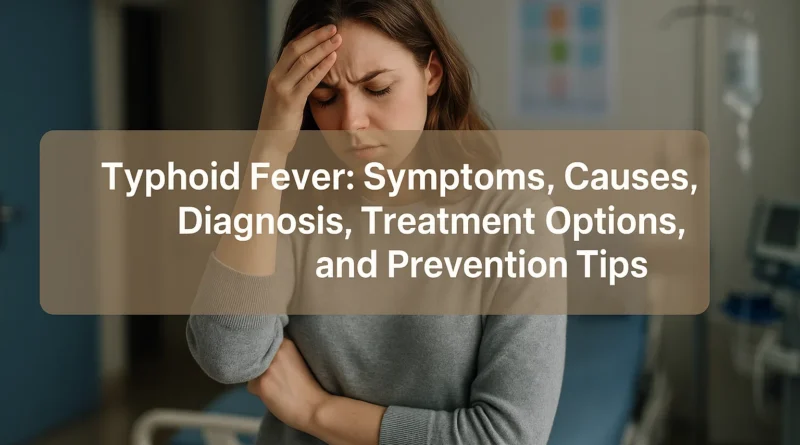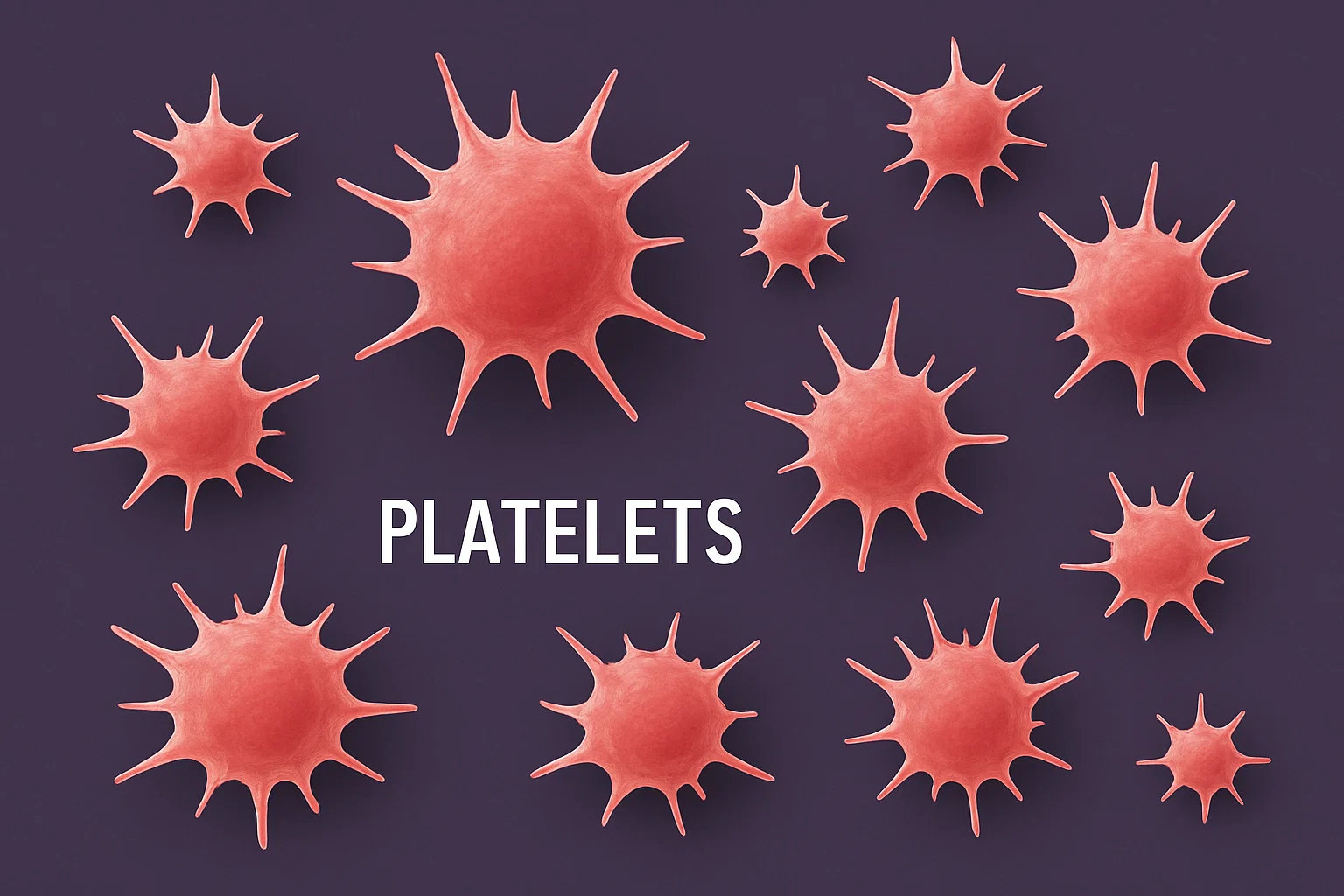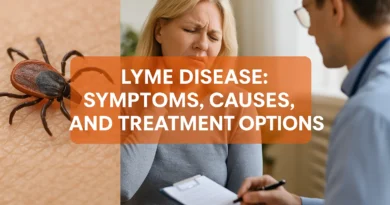Typhoid Fever: Symptoms, Causes, Diagnosis, Treatment Options, and Prevention Tips
Typhoid fever is a serious bacterial infection that mainly affects the intestines and can spread throughout the body if not treated. According to the WHO, around 10-20 million people are affected by typhoid worldwide, leading to approximately 128,000-160,000 deaths in one year. In India, typhoid remains a major public health issue, especially in areas with poor sanitation and limited access to clean water.
In this article, we will get to know about typhoid symptoms, causes, and treatment options, which are essential for preventing complications and managing it effectively.
What is Typhoid fever?
Typhoid fever is caused by the bacterium Salmonella Typhi and is primarily transmitted through contaminated food and water. Once inside the body, the bacteria multiply and enter the bloodstream, affecting multiple organs.
How is typhoid spread?
Here are some of the ways that can increase the risk of typhoid fever.
- Contaminated food or water.
- An area with Poor sanitation or hygiene practices.
- Close contact with an infected person.
- Eating raw fruits or vegetables washed with contaminated water.
What are the Causes of typhoid fever?
- Contaminated food and water
Water sources like wells, rivers, or public taps are at high risk of contamination with fecal matter containing Salmonella Typhi. Direct intake of this water or using it for washing food can lead to infection. In areas where sewage and drinking water systems are poorly separated, this risk is especially high.
- Poor sanitation and hygiene
People who excrete waste in the open or sewage leaks into water bodies can raise the risk of bacteria spreading in the community. People who use that water to clean utensils, wash vegetables, or bathe are unaware that they are exposing themselves to typhoid bacteria.
- Close Contact with an Infected Person
Typhoid is transmissible, meaning it can spread through contact with objects or surfaces contaminated by an infected person. Sharing food, like eating from the same plate or sharing water or utensils with an infected individual without proper hygiene precautions, can lead to infection.
What are the risk factors associated with typhoid fever?
Several risk factors can increase the risk of typhoid fever; these include
- Living in Areas with Poor Sanitation
Communities with improper sewage systems or water treatment facilities are at higher risk. - Lack of Access to Clean Water
Consuming untreated or open water sources increases exposure to contamination. - Unhygienic Practices
Failing to wash hands after defecation or before handling food can spread the infection within households and communities. - Open Defecation
Raises the risk of flies transferring fecal matter to food or water sources. - Consumption of Uncooked or Street Food
Raw vegetables without proper cleaning or seafood from polluted waters come with a higher risk. - Lack of Vaccination
Unvaccinated Individuals, especially children living in a slum area with poor sanitation, are at high risk of contracting this bacterium.
- Travel to endemic Areas
Travelers in the region where typhoid risk is high are more likely to contract the disease. Be alert and take proper precautions.
What are the common Symptoms of Typhoid Fever?
Typhoid symptoms range from mild to severe and appear slowly over 7–14 days after exposure.
Early Symptoms
- Persistent high fever (up to 104°F or 40°C)
- Weakness and fatigue
- Headache
- Discomfort or pain in the Abdomen
- Loss of appetite
Late-stage Symptoms
- Diarrhea or constipation (varies by age)
- Rose-colored spots on the chest or abdomen
- Enlarged liver and spleen
- Mental delusions or confusions (in severe cases)
Note: If you have any of the above symptoms, consult with your doctor for immediate treatment and diagnosis to manage the disease effectively and to prevent any further complications.
What are the Stages of typhoid fever?
Typhoid fever gradually develops through 4 stages marked by distinctive symptoms; these are
Stage 1 (1st Week)
- Slowly increasing, fever often reaches 104°F (40°C) by the end of the week.
- Patients may develop a progressive feeling of weakness, body aches, general malaise, and chronic headaches.
- Loss of appetite, mild abdominal discomfort, and dry cough may occur.
- Diarrhea is less common than constipation, especially in adults.
Stage 2 (2nd Week)
Symptoms become more severe and specific.
- The fever is high and persistent, usually with no daily variations.
- Constipation is still more common in adults, but abdominal pain gets worse, and diarrhea can appear, especially in kids.
- A characteristic rash known as “rose spots”—tiny pink macules—may develop on the abdomen and chest.
- Extreme fatigue, mental apathy, or even dizziness are often observed in patients; this condition is known as the “typhoid state.”
Stage 3 (3rd Week)
This is the most dangerous stage, marked by serious complications.
- Symptoms worsen, and patients may become seriously ill or bedridden.
- Prolonged high fever with diarrhea or distension in the abdomen.
- A high risk of intestinal perforation results in the potentially fatal abdominal infection known as peritonitis.
- The bacteria may enter the bloodstream and may increase the risk of sepsis.
- Confusion, low blood pressure, and dehydration are frequent, particularly if treatment is not received.
Stage 4 (4th Week and Beyond)
Recovery begins gradually if appropriate antibiotic treatment is administered.
- Over time, the fever gradually goes away, and energy levels begin to rise again.
- After an initial period of improvement, relapse may occur in certain cases, necessitating ongoing medical supervision.
- A small percentage of patients may become chronic carriers of Salmonella typhi, especially if the bacteria persist in the gallbladder. Typically asymptomatic, they silently infect others.
How is typhoid fever diagnosed?
Typhoid fever requires an early and precise diagnosis in order to be properly treated and for complications to be avoided. Certain diagnostic tests are necessary because their symptoms can mimic those of other infections, such as viral fever, dengue, or malaria.
Test for typhoid fever
- Blood culture test
A blood sample is taken and cultured in the lab for the Salmonella bacterium, most effective in the first week of illness, usually before the antibiotics are taken.
- WIDAL test
It is a common and widely used test in developing countries that detects antibodies (agglutinins) against the bacterium; a positive result from this test needs to be confirmed by another test. If a person has had a typhoid infection previously.
- Typhidot test
Rapid test that detects the IgM (for current or recent infection) and IgG (for past infection) antibodies specific to Salmonella typhi, Faster than culture and useful in areas lacking advanced labs.
- Stool Test
Examine the feces to detect the presence of Salmonella, effective during the 2nd-3rd week of illness or when blood cultures are negative.
- Bone Marrow test
Used during complicated or chronic infections. It can detect bacteria even when the other test shows a negative response or if the person is on antibiotics.
Advice: Clinical Correlation is necessary after diagnosis to better rule out and confirm the disease. Consult with your doctor accordingly.
What are the Treatment Options for typhoid fever?
Typhoid fever is treatable and primarily involves antibiotics, supportive care, and preventive measures to manage symptoms and complications. Early treatment is the key to successful recovery.
Treatment with Antibiotics
Antibiotics are the first line of treatment to control typhoid. Some of the antibiotics, including Ciprofloxacin, Azithromycin, and Cefixime, are effective in eliminating Salmonella from our bodies. Things to note
- Complete the full course of medicine
- Avoid self-medication to avoid drug resistance
Supportive care at home
As the body takes time to heal, it is crucial for fast recovery to prevent relapse.
Be Hydrated: Drink Oral Rehydration solutions(ORS), coconut water, and soup, especially during diarrhea (which leads to loss of electrolytes and fluids), to prevent dehydration.
Nutritious diet: For a quick recovery, eat Khichdi, boiled vegetables, curd rice; soothe your digestive system and support immune health to fight infection
Note: Take proper rest for at least 7-10 days along with good nutrition, as lack of it can increase the chance of relapse.
Hospitalisation( In emergency)
In severe cases or complications, such as very high fever, vomiting, and diarrhea, inpatient care may be required. IV fluids are given to prevent dehydration, and IV antibiotics may be used for faster action.
In some cases, surgeries may be required; if complications like intestinal perforations occur, surgery may be required to fix them and prevent a serious infection called peritonitis.
How to Prevent Typhoid Fever?
Typhoid fever prevention is entirely possible with a combination of good hygiene, vaccination, and safe eating habits. Here are some of the ways to reduce your risk.
Drink safe water
The primary source of typhoid is contaminated drinking water, especially in areas where hygiene and sanitation are major concerns.
Tips to avoid typhoid
- Use boiled water
- Make use of a high-quality water purifier.
- Avoid using ice in drinks unless it’s made from clean water.
Maintaining Good Hygiene habits
Unwashed hands are a major source of typhoid and other types of bacteria, especially before eating.
Tips for good hygiene
- Wash your hands properly, especially encourage kids
- Use Hand sanitizer outside.
- Don’t touch any contaminated surface, and avoid hand contact with an infected person’s belongings.
Eat well-cooked and Fresh Food
Undercooked food or eating raw vegetables can transmit Salmonella.
Tips for safe eating
- Wash foods before consuming them raw in salads.
- Avoid eating street food if the cleanliness is inadequate.
- Eat hot and freshly cooked foods, and avoid any unsafe eating.
Get Typhoid Vaccination
Especially important for children and people having high risk, like travelers or persons with low immunity. Vaccination reduces the risk of typhoid by 80%
Available vaccines:
- Vi polysaccharide vaccine (every 2 years)
- Typhoid conjugate vaccine (TCV) (longer protection)
Advice: If you live in a high-risk area or are traveling, ask your doctor about the typhoid vaccination.
Final Thought
Typhoid fever is still a dangerous but avoidable disease, particularly in areas with persistent problems with hygiene and sanitation. In the majority of cases, full recovery can be achieved with early diagnosis, suitable antibiotic treatment, and supportive care.
But awareness, precautions like drinking clean water and eating safe food, vaccination, and practicing better hygiene practices are essential to preventing its spread. Consult with the best doctor around you. Staying informed and proactive helps individuals and communities reduce the risk of typhoid and protect public health.
FAQs
Can typhoid become a chronic disease?
Yes, in rare cases. Some people become “carriers,” shedding bacteria in their stool or urine without exhibiting any symptoms. They may unintentionally spread typhoid unless properly treated and cleared.
Is typhoid fever similar to any other illness?
Yes. Early typhoid symptoms, such as fever, fatigue, and digestive upset, can be confused with dengue, malaria, influenza, or viral gastroenteritis. In areas where these are common, only laboratory tests, such as blood or stool cultures, can confirm typhoid.
In what ways does typhoid fever spread within families or communities?
It spreads due to poor hygiene. If an infected person handles food without washing their hands or shares utensils, the bacteria can easily spread to others. Contaminated water, shared toilets, and unclean surfaces all increase the risk.
What are the warning signs that typhoid is becoming severe?
High fever (>102°F), severe abdominal pain, black stools, confusion, or bleeding are all potential warning signs. Untreated severe typhoid can cause intestinal perforation, sepsis, or death, so these patients require immediate hospitalization.
Can you contract typhoid more than once?
Yes. Immunity after recovery is temporary. Re-infection is possible if exposed to contaminated food or water again. Hygiene and vaccination remain important after recovery.
What do rose spots in typhoid indicate?
They are small, pink rashes on the chest or abdomen that may appear in the second week of infection. Not all patients develop them, but when present, they help confirm the diagnosis.
How does typhoid affect children differently?
Children, especially under five, may show irritability, poor appetite, or lethargy instead of classic symptoms. Diarrhea is more common in kids than constipation. Dehydration can occur faster, so early care is critical.
Is it safe to cook or serve food after recovering from typhoid?
No, not immediately. Some may shed bacteria even after symptoms disappear. Patients should avoid food handling until cleared by a doctor, especially if working in food service.
Can typhoid be prevented during an outbreak?
Yes. Boil water, avoid raw street food, and wash hands frequently. Follow local health advisories, and consider vaccination if living in or visiting an affected area.
What foods support recovery from typhoid?
Choose soft, low-fiber foods like khichdi, mashed potatoes, bananas, toast, and applesauce. Drink coconut water, soup, or buttermilk to stay hydrated. Avoid spicy, oily, or raw foods until you’ve fully recovered.
What to do if someone in the family is diagnosed?
Practice strict hygiene: handwashing, disinfecting surfaces, using separate utensils, and boiling drinking water. Avoid food prepared by the patient. In some cases, other family members may need testing.
Are there long-term effects of typhoid?
Most recover fully. Some may feel tired or have digestive issues for a few weeks. Rarely, chronic complications like intestinal strictures or gallbladder problems may occur.
How do doctors choose which tests to use?
It depends on the illness duration. A blood culture is most accurate early on. Widal or other antibody tests may be used starting in week two. Later on, stool and urine tests are helpful. A bone marrow test has the highest accuracy in complex cases.




